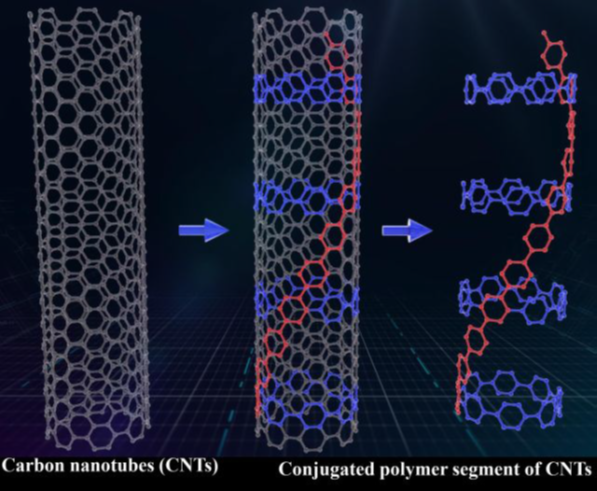Progress Made on The Structure of Single-Walled Carbon Nanotubes
Carbon nanotubes can be considered as all-carbon tube-shaped conjugated polymers containing only sp2-bonded atoms, which play an important role in nanotechnology and nanoelectronics. So far, no study has reported the realization of long π-conjugated polymers as diameter-specified carbon nanotube segments.
Recently, the research team led by Prof. DU Pingwu from University of Science and Technology of China (USTC) of the Chinese Academy of Sciences, reported the first synthesis of a π-conjugated polymeric segment (PS1) of armchair single-walled carbon nanotubes (SWCNTs). The study was published in Journal of the American Chemical Society.
Carbon nanotubes (CNTs) have attracted much attention due to their unique electronic, optical, thermal, mechanical, and chemical properties. However, till now the practical applications of CNTs have been significantly limited.
To obtain a real CNT, it is highly desirable to extend the π systems longitudinally. As a well-known prototype conjugated polymer, poly-paraphenylene (PPP) polymers have been widely studied, resulting in various synthesis approaches1-3 and the fabrication of photoactive devices.
In the study, researchers design a bifunctionalized cyclo-para-phenylene that mimics the curved cyclic polyphenylene part of a CNT and a linear PPP backbone that mimics the linear polyphenylene part along the 1D direction of the CNT.

The design of a long π-extended poly-para-phenylene-based polymeric segment of armchair single-walled carbon nanotube. (Image by HUANG Qiang et al.)
Considering the remarkable electronic properties of carbon nanotubes and related structures and the novel polymeric structure of PS1 as a long polymeric segment of carbon nanotubes, researchers examined the potential applications of PS1 as the electron- and hole-transport layers for optoelectronic devices on the electron mobility, which is measured by the space charge limited current (SCLC) method.
Researchers successfully synthesized a novel π-extended polymer (PS1) containing a cyclo-para-phenylene unit and a PPP backbone. This long π-extended polymer PS1 represents a key step toward the bottom-up synthesis of uniform carbon nanotubes and provides potential applications in electron- and hole-transport devices.
Paper link:
https://pubs.acs.org/doi/10.1021/jacs.9b10358
(Written by LI Xiaoxi, edited by JIANG Pengcen, USTC News Center)

